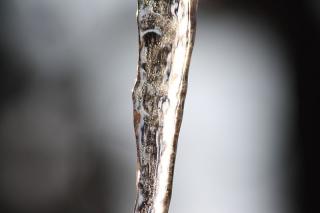What Causes Ice Dams?
Ice dams make for some interesting winter photography, but can cause major financial headaches for Minnesota homeowners.
Not everyone is familiar with the term, but we’ve all seen ice dams—they’re the ridged build-up of ice and icicles at the edge of a roof.
They’re caused by a temperature differential: Heat escapes from one part of a house and melts the snow on the roof above it; the water flows away, only to freeze once it reaches a colder portion of the roof. Snow can then back up behind the ice dam. The snow can pile up underneath shingles and, if it’s warm enough, leak into the house.
Inadequate insulation and air leakage from the house are major underlying causes. The situation can be exacerbated by bath and exhaust fans that vent into the attic, rather than outside through the roof.
The large icicles that result can be a significant safety hazard for passersby. But they can also cause expensive structural damage.
Roof and Ceiling Damage
Leaking water from ice dams can erode shingles, gets the roof decking and insulation wet, and may gradually ruin the plaster or sheetrock underneath. In some situations, the sheer weight of the ice and snow build up can damage roofs and gutters.
Often this results in tell-tale water stains that alert homeowners to the fact that they have a problem.
Why You Should Care
NEC Quality Assurance Manager Phil Anderson is used to getting a lot of calls about ice dams, especially when snowfall is heavy and temperatures are relatively high.
Usually, says Anderson, homeowners see the ceiling stains that result from leakage and realize they have a problem. But if they don’t, the results can be costly.
“The ceiling gets saturated with water and the whole thing falls down. You have to redo the ceiling, the roof and the roof deck. That can cost thousands of dollars.”
Which Homes are at Risk?
Ice dams are especially prevalent in Minnesota homes that were built before the introduction of the state’s first energy code in 1976. That’s roughly half of the total housing stock.
Anderson explains that newer homes are subject to energy code regulations, so they usually have fewer air leaks, higher insulation levels, and better ventilated roofs. Additionally, recent improvements in roof truss design make newer homes less likely to be affected.
Ice Dam Removal and Prevention
Homeowners who want to remove ice dams have a variety of options. In the short term, they can remove snow from their roof with a roof rake, hire a professional to melt the ice dam with a heater, or use electrical heating cables. Each of these options can be expensive and none of them get at the root of the problem.
The best long-term solutions involve air sealing and adding insulation and/or ventilation. These actions ensure that heat stays in the house, and doesn’t escape to the roof, where it can melt snow and cause ice dams to form.
Home energy audits are a great way to start the process. A trained energy expert can identify the areas where heat is escaping from your roof and write up a detailed scope of work for roofing and insulation contractors.
Anderson stresses that people often ignore ice dams for years. But once the right weather hits or damage builds up, it’s often too late to avoid unwelcome expenditures.
“If people aren’t aware, they’ll wait until it’s too late. The best solution is to have an expert come and identify potential problems."
If you'd like to read a more technical article about the causes of ice dams, check out this piece from the Building Science Corporation.
Read another blog post about common home performance issues.
Learn more about the NEC's home energy audit services.

Max Bielenberg is a communications specialist with the Neighborhood Energy Connection. He helps to tell the NEC’s story through social media, blog posts and website content. When he’s not reading up on residential energy savings, he enjoys riding his bike around town. You can connect with Max on LinkedIn.






